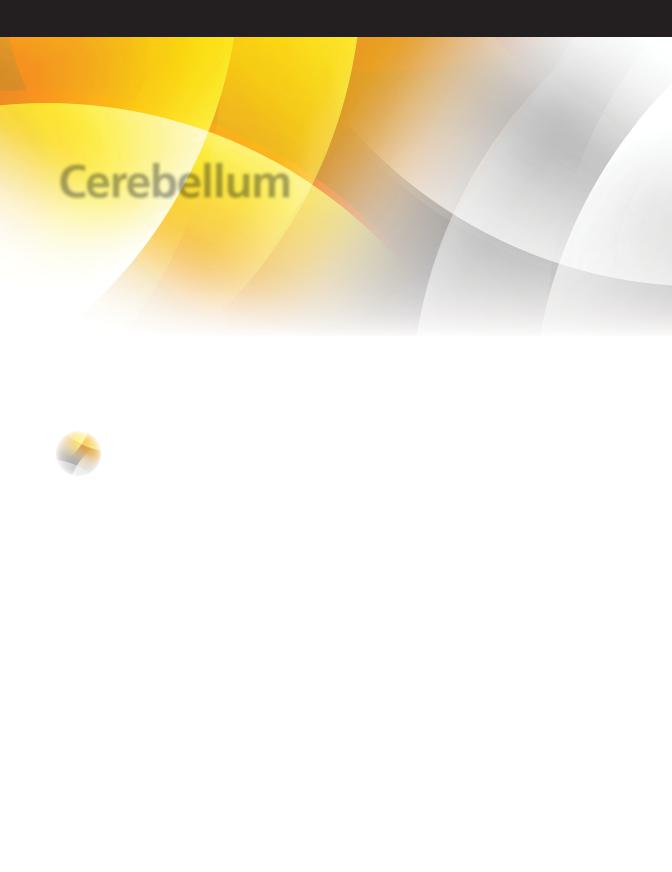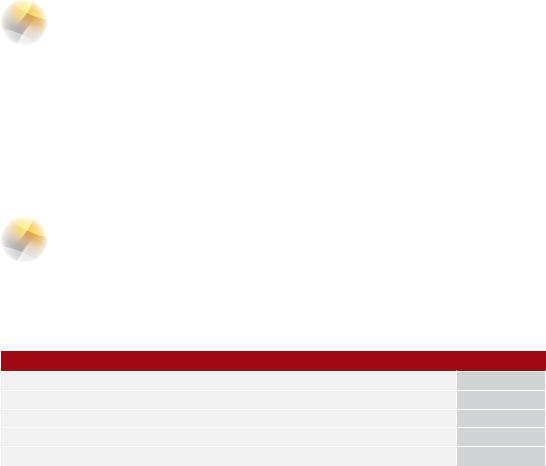
- •Objectives
- •Objectives
- •IX Congenital Malformations of the CNS
- •Objectives
- •VI Regeneration of Nerve Cells
- •Objectives
- •VI Venous Dural Sinuses
- •VII Angiography
- •Objectives
- •Objectives
- •IV Location of the Major Motor and Sensory Nuclei of the Spinal Cord
- •Case 6-1
- •Case 6-2
- •VII Conus Medullaris Syndrome (Cord Segments S3 to C0)
- •Objectives
- •Lesions of the Brainstem
- •Objectives
- •Objectives
- •VII The Facial Nerve (CN VII)
- •Objectives
- •IV Trigeminal Reflexes
- •Objectives
- •Objectives
- •IV Auditory Tests
- •Objectives
- •Objectives
- •VI Cortical and Subcortical Centers for Ocular Motility
- •VII Clinical Correlation
- •Objectives
- •IV Clinical Correlations
- •Objectives
- •Objectives
- •VI Cerebellar Syndromes and Tumors
- •Objectives
- •Objective
- •Objectives
- •I Major Neurotransmitters

C H A P T E R 1 7
Cerebellum
Objectives
1.Be able to identify the cerebellar peduncles as to their location and relationships and describe the main contents of each.
2.Describe the cerebellar cortex and be able to identify the major cell types found in each layer.
3.Describe the Purkinje cell and its connections.
4.Identify the deep cerebellar nuclei and their output targets.
5.Assess the result(s) of cerebellar dysfunction and describe the symptoms associated with cerebellar syndromes and disorders.
I Function. The cerebellum has three primary functions:
A.Maintenance of Posture and Balance
B.Maintenance of Muscle Tone
C.Coordination of Voluntary Motor Activity
Lateral zone of hemisphere |
Paravermal zone of hemisphere |
|
Vermis |
|
Lingula |
Ant. lobe |
Primary fissure |
|
 Horizontal fissure
Horizontal fissure
Post. lobe |
|
|
|
|
|
|
|
Tonsil |
|
|
|
|
Posterolateral fissure |
|
Flocculonodular |
|
|
|
|
lobe |
|
|
Vermal zone |
|
|
|
|
||
Nodulus |
Uvula |
Flocculus |
Paravermal zone |
|
of hemisphere |
||||
|
|
|
||
|
|
|
Lateral zone |
|
|
|
|
of hemisphere |
Figure 17-1 Longitudinal divisions of the cerebellum.
126

Corticopontine neuron
Corticospinal neuron
Emboliform nucleus
Dentate nucleus
Globose nucleus
Pontine nucleus
Pyramidal decussation
Cerebellum 127
Ventral lateral nucleus of thalamus
Internal capsule (posterior limb)
Lentiform nucleus
Red nucleus
Superior cerebellar peduncle

 Purkinje cell
Purkinje cell
Middle cerebellar peduncle
Rubrospinal tract
Corticospinal tract
Figure 17-2 The principal cerebellar connections. The major efferent pathway is the dentatothalamocortical tract. The cerebellum receives input from the cerebral cortex through the corticopontocerebellar tract.
IIAnatomy
A.Gross anatomically, the cerebellum may be divided longitudinally into lobes, or laterally into zones (Figure 17-1).
1.Longitudinally the primary fissure forms an anterior lobe and posterior lobe. The posterolateral fissure separates a flocculonodular lobe from the more anterior posterior lobe (Figure 17-1).
2.Laterally the cerebellum is divided into a large lateral zone or hemisphere, a smaller intermediate (or paravermal) zone and a midline vermal zone (Figure 17-2).
B.Cerebellar Peduncles
1.The superior cerebellar peduncle is attached to the brainstem at the caudal midbrain and rostral pons and it contains the major output from the cerebellum, the dentatothalamic tract. This tract terminates in the ventral lateral nucleus of the thalamus. It has one major afferent pathway, the anterior spinocerebellar tract.
2.The middle cerebellar peduncle, the largest cerebellar peduncle is connected to the brainstem at mid-pons, it contains the pontocerebellar fibers, which project to the neocerebellum (pontocerebellum).
3.The inferior cerebellar peduncle, connected to the caudal pons and rostral medulla, has three major afferent tracts: the posterior spinocerebellar tract, the cuneocerebellar tract, and the olivocerebellar tract from the contralateral inferior olivary nucleus.

128 Chapter 17
C.Cerebellar Cortex, Neurons, and Fibers
1.The cerebellar cortex has three layers:
a.The molecular layer is the most superficial, underlying the pia mater. It contains stellate cells, basket cells, and the dendritic arbor of the Purkinje cells.
b.The Purkinje cell layer lies between the molecular and the granule cell layers.
c.The granule layer is the deepest layer overlying the white matter. It contains granule cells, Golgi cells, and cerebellar glomeruli. A cerebellar glomerulus consists of a mossy fiber rosette, granule cell dendrites, and a Golgi cell axon.
2.Neurons and fibers of the cerebellum
a.Purkinje cells convey the only output from the cerebellar cortex. They project inhibitory output (i.e., γ-aminobutyric acid [GABA]) to the cerebellar and vestibular nuclei. Purkinje cells are excited by parallel and climbing fibers and inhibited by GABA-ergic basket and stellate cells.
b.Granule cells excite (by way of glutamate) Purkinje, basket, stellate, and Golgi cells through parallel fibers. They are inhibited by Golgi cells and excited by mossy fibers.
c.Parallel fibers are the axons of granule cells. These fibers extend into the molecular layer.
d.Mossy fibers are the afferent excitatory fibers of the spinocerebellar, pontocerebellar, and vestibulocerebellar tracts. They terminate as mossy fiber rosettes on granule cell dendrites. They excite granule cells to discharge through their parallel fibers.
e.Climbing fibers are the afferent excitatory (by way of aspartate) fibers of the olivocerebellar tract. These fibers arise from the contralateral inferior olivary nucleus. They terminate on neurons of the cerebellar nuclei and dendrites of Purkinje cells.
III The Deep Cerebellar Nuclei are found within the white matter and represent the output nuclei of the cerebellum. Functionally, the nuclei may be associated with more sophisticated function as one moves away from the midline (Table 1 and Figure 17-2).
A.Fastigial Nucleus—the most midline nucleus is associated with the paleocerebellum and deals with balance and equilibrium.
B.Interposed Nuclei (Globose and Emboliform)—associated with the archicerebellum deal with walking and arm movements.
C.Dentate Nucleus—the most lateral and the largest, is part of the neocerebellum and is associated with highly skilled movements, such as stacking a house of cards. Gives rise to dentatothalamic tract.
IV The Major Cerebellar Circuit Influences ongoing motor activity. It consists of the following structures:
A.The Purkinje cells of the cerebellar cortex project to the deep cerebellar nuclei (e.g., dentate, interposed (emboliform and globose), and fastigial nuclei).
Table 17-1: Divisions of the Cerebellum
Anatomical |
Phylogenetic |
Functional |
Deep Nucleus |
Anterior lobe |
Paleocerebellum |
Spinal cerebellum |
Interposed |
|
Primary fissure |
|
|
Posterior lobe |
Neocerebellum |
Cerebral cerebellum |
Dentate |
|
Posterolateral fissure |
|
|
Flocculonodular lobe |
Archicerebellum |
Vestibular cerebellum |
Fastigial |

Cerebellum 129
B.The dentate nucleus is the major effector nucleus of the cerebellum in humans. It gives rise to the dentatothalamic tract, which projects through the superior cerebellar peduncle to the contralateral ventral lateral nucleus of the thalamus. The decussation of the superior cerebellar peduncle is in the caudal midbrain tegmentum.
C.The ventral lateral nucleus of the thalamus receives the dentatothalamic tract. It projects to the primary motor cortex of the precentral gyrus (Brodmann area 4).
D.The motor cortex (Brodmann area 4) receives input from the ventral lateral nucleus of the thalamus. It projects as the corticopontine tract to the pontine nuclei.
E.The pontine nuclei receive input from the motor cortex. Axons project as the pontocerebellar tract to the contralateral cerebellar cortex, where they terminate as mossy fibers, thus completing the circuit.
VCerebellar Dysfunction includes the following triad:
A.Hypotonia is loss of the resistance normally offered by muscles to palpation or passive manipulation. It results in a floppy, loose-jointed, rag-doll appearance with pendular reflexes. The patient appears inebriated.
B.Dysequilibrium is loss of balance characterized by gait and trunk dystaxia.
C.Dyssynergia is loss of coordinated muscle activity. It includes dysmetria, intention tremor, failure to check movements, nystagmus, dysdiadochokinesia, and dysrhythmokinesia. Cerebellar nystagmus is coarse. It is more pronounced when the patient looks toward the side of the lesion.
VI Cerebellar Syndromes and Tumors
A.Anterior Vermis Syndrome involves the lower limb region of the anterior lobe. It results from atrophy of the rostral vermis, most commonly caused by alcohol abuse. It causes gait, trunk, and lower limb dystaxia.
B.Posterior Vermis Syndrome involves the flocculonodular lobe. It is usually the result of brain tumors in children and is most commonly caused by medulloblastomas or ependymomas. It causes truncal dystaxia.
C.Hemispheric Syndrome usually involves one cerebellar hemisphere. It is often the result of a brain tumor (astrocytoma) or an abscess (secondary to otitis media or mastoiditis). It causes arm, leg, and gait dystaxia and ipsilateral cerebellar signs.
D.Cerebellar Tumors. In children, 70% of brain tumors are found infratentorially, in the posterior fossa. In adults, 70% of brain tumors are found in the supratentorial compartment.
1.Astrocytomas constitute 30% of all brain tumors in children. They are most often found in the cerebellar hemisphere. After surgical removal of an astrocytoma, it is common for the child to survive for many years.
2.Medulloblastomas are malignant and constitute 20% of all brain tumors in children. They are believed to originate from the superficial granule layer of the cerebellar cortex. They usually obstruct the passage of cerebrospinal fluid (CSF). As a result, hydrocephalus occurs.
3.Ependymomas constitute 15% of all brain tumors in children. They occur most frequently in the fourth ventricle. They usually obstruct the passage of CSF and cause hydrocephalus.

130 Chapter 17
CASE 17-1
A 50-year-old woman presented with a history of poor coordination of hands, speech, and eye movements, accompanied by personality changes and some deterioration of intellectual function.
Relevant Physical Exam Findings
●Neurologic examination revealed marked cerebellar ataxia and spasticity of all extremities, held in a flexed posture. Babinski sign was negative. The sensory system appeared normal.
Relevant Lab Findings
●Laboratory results were unremarkable. A brain computed tomography scan showed generalized cerebral atrophy, most pronounced in the cerebellum.
Diagnosis
●Spinocerebellar ataxia is a genetic disease that is characterized by progressive loss of coordination of gait, with frequent involvement of hands, speech, and eye movements. At least 29 different gene mutations have been associated with the various forms of this disease.
